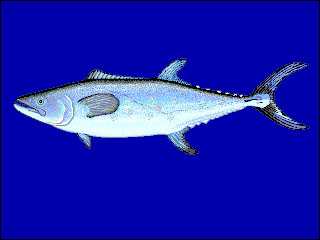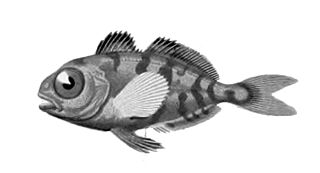
Nomeidae, the driftfishes, are a family of scombriform ray-finned fishes found in tropical and subtropical waters throughout the world. The family includes about 16 species. The largest species, such as the Cape fathead, Cubiceps capensis, reach 1 m in length.
The squaretails are a genus, Tetragonurus, of scombriform ray-finned fishes, the only genus in the family Tetragonuridae.

Psenes pellucidus, the bluefin driftfish, is a species of driftfish native to the Atlantic, Indian and Pacific oceans where it is found in deep waters to a depth of 1000 m. ). It is also present in low abundance since the mid-20th century in the western Mediterranean Sea which it most likely entered via the Strait of Gibraltar. It can reach a length of 80 cm TL.

Psenes is a genus of driftfishes native to the Indian, Atlantic and Pacific oceans.

Epinnula is a genus of fish in the family Gempylidae.
The Papuan seerfish also called the Papuan Spanish mackerel, is a species of fish in the family Scombridae. It is endemic to the Gulf of Papua off the mouth of the Fly River. It is the smallest species in the genus Scomberomorus. Sexual maturity is attained at much less than 30 cm fork length.

The Serra Spanish mackerel is a species of fish in the family Scombridae. Specimens have been recorded at up to 125 cm in length, and weighing up to 6.71 kg. It is found in the western Atlantic, along the Caribbean and Atlantic coasts of Central and South America from Belize to Rio Grande do Sul, Brazil. Literature records for S. maculatus from the area apply to S. brasiliensis, which has erroneously been considered a synonym of S. maculatus by many authors. It feeds on small fish, squid/cuttlefish, shrimp/prawn, and isopods.

The slender sole is a species of flatfish in the family Pleuronectidae. It is a demersal fish that lives on bottoms near rocky areas at depths of between 25 and 800 metres. Its native habitat is the eastern Pacific coast, from the mouth of the Alsek River in Alaska in the north to Isla Cedros in Baja California, Mexico in the south. It can reach up to 35 centimetres (14 in) in length.

Euthynnus affinis, the mackerel tuna, little tuna, eastern little tuna, wavyback skipjack tuna, kawakawa, or tongkol komo is a species of ray-finned bony fish in the family Scombridae, or mackerel family. It belongs to the tribe Thunnini, better known as the tunas. This is an Indo-Pacific species which is found from the Red Sea to French Polynesia.

The Chinese mackerel, also known as the Chinese seerfish, is a ray-finned bony fish in the family Scombridae, better known as the mackerel family. More specifically, this fish is a member of the tribe Scomberomorini, the Spanish mackerels. It is a marine species occurring in the Western Pacific Ocean, but it also enters the Mekong River.
Dagetichthys lakdoensis is a species of freshwater sole native to the Bénoué basin in Cameroon, with recent records from Nigeria in the Niger Delta. This species grows to a length of 40 centimetres (16 in) TL. This species is one of three known members of its genus, the others being the marine Dagetichthys lusitanicus and Dagetichthys marginatus

Brama orcini is a species of scombriform ray-finned fish in the family Bramidae (pomfrets).
Brama myersi is a species of scombriform ray-finned fish in the family Bramidae.
Cubiceps pauciradiatus is a species of ray-finned fish in the family Nomeidae (driftfishes).
Samariscus triocellatus is a species of flatfish in the family Samaridae.

Engyprosopon xenandrus is a species of flatfish in the family Bothidae.

Parabothus chlorospilus is a species of flatfish in the family Bothidae.
Psenes arafurensis is a species of scombriform ray-finned fish in the family Nomeidae (driftfishes).
Psenes sio is a species of scombriform ray-finned fish in the family Nomeidae (driftfishes).

Psenes maculatus is a species of marine ray-finned fish of the order Scombriformes in the family Nomeidae (driftfishes).












